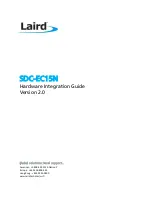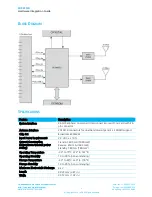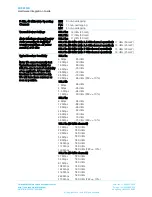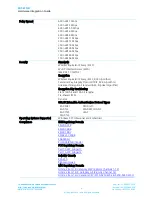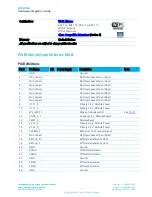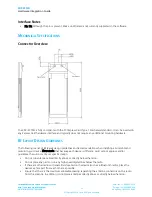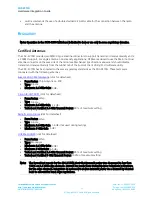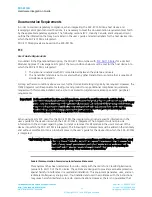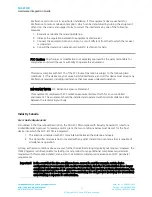
SDC-EC15N
Hardware Integration Guide
Embedded Wireless Solutions Support Center:
http://ews-support.lairdtech.com
www.lairdtech.com/bluetooth
4
© Copyright 2015 Laird. All Rights Reserved
Americas: +1-800-492-2320
Europe: +44-1628-858-940
Hong Kong: +852 2923 0600
S
COPE
This document describes key hardware aspects of the Laird SDC-EC15N wireless LAN radio card. This
document is intended to assist device manufacturers and related parties with integration of this card into their
host devices. Data in this document are drawn from a number of sources and includes information found in
the Broadcom BCM4322 data sheet issued in August of 2008.
The SDC-EC15N is currently in pre-production and as such, this document is preliminary in nature. The
information in this document is subject to change without notice. Please contact Laird or visit the
to obtain the most recent version of this document.
O
PERATIONAL
D
ESCRIPTION
This device is an SDC-EC15N, an IEEE 802.11n-compliant Peripheral
Components Interconnect (PCIe) Express Card which operates in the 2.4 GHz
and 5 GH portions of the radio frequency spectrum. The device is compliant
with IEEE 802.11a, 802.11b, 802.11g, and 802.11n standards using Direct
Sequence Spread Spectrum and Orthogonal Frequency Division Multiplexing.
The device supports all 802.11a, 802.11b, and 802.11g data rates and select
802.11n data rates and automatically adjusts data rates and operational
based on various environmental factors.
When operating on channels in the 5GHz portion of the frequency spectrum
that are subject to Dynamic Frequency Selection requirements, the
fully conforms to applicable regulatory requirements. In the event that
types of radar are detected by the network infrastructure, the SDC-EC15N
conforms to commands from the infrastructure for radar avoidance.
The SDC-EC15N is compliant with 32-bit PCIe Express Card mechanical specifications and interfaces to host
devices via a 26-pin connector. The device is based on the Broadcom BCM4322 chip which is an 802.n
compliant integrated device providing a Media Access Controller (MAC), a Physical Layer Controller (PHY or
baseband processor), and fully integrated dual-band radio transceiver that provides 2x2 antenna and MIMO
support. The frequency stability for both 2.4 GHz (802.11b and 802.11g) and 5 GHz (802.11a) operation is +/-
20 ppm.
The SDC-EC15N has its own RF shielding and does not require shielding provided by the host device into
which it is installed in order to maintain compliance with applicable regulatory standards. Because of this, the
device may be tested in a standalone configuration via an extender card.
The device buffers all data inputs so that it will comply with all applicable regulations even in the presence of
over-modulated input from the host device. Similarly, the SDC-EC15N incorporates power regulation to
comply with all applicable regulations even when receiving excess power from the host device.
The SDC-EC15N incorporates two Hirose U.FL antenna connectors that support dual band diversity when
operating in 802.11a, 802.11b and 802.11g modes and 2 x 2 MIMO support when operating in 802.11n
mode.
The device is labeled with all applicable regulatory information in a manner that’s compliant with all regulatory
standards. Regulatory operational requirements are included with this document and may be incorporated
the operating manual of any device into which the SDC-EC15N is installed. The EC15N is designed for
installation into mobile devices such as notebook computers which typically operate at distances greater than
20 cm from the human body. See

